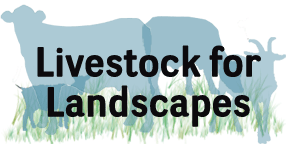


Educated Cows Eat Weeds! |
Cows Start on Late-Season Diffuse Knapweed and Dalmatian Toadflax.... |
And Add More and More Weeds! |
2007 - Diffuse Knapweed I trained the heifers in a large pasture. Sometimes they walked as much as a mile to come to the feeding site, responding to a honking horn. They also became very familiar with grain bags and if they were in sight, it was just as easy to call them in by waving an empty grain sack and calling "Heifers!" By Day 9 the heifers were grazing knapweed in their 2.11 acre trial pasture just as well as they grazed grass. 2008 - Dalmatian Toadflax We reintroduced them to the tubs so that we could use them to lead the herd to their trial pasture. Then we added Dalmatian toadflax. Calves ate more of the Dalmatian toadflax in training, and cows and calves both ate it in pasture. Having bulls in the herd didn't seem to change their ability to learn, though it did change how easy it was to move them across the large pasture. Keep this in mind when working with your own cows and bulls. |
2009 - Cows Don't Eat Grass The herd grazed with 38 untrained cow-calf pairs in a 500-acre pasture, near Boulder, Colorado. June and July 2009 were two of the wettest months in history and grasses rebounded and forbs went wild. A large prairie dog ghost-town that covered about 200 acres of the pasture, was vacant because of plague. It was grassless, and covered in an assortment of weeds. It looked so bad from our accepted pasture paradigm that I nicknamed it the "garbage area." But it didn't look bad to my weed-eating trained cows. They avoided the grassy areas and spent their time in the "garbage area" snipping off sunflower blossoms, yucca fruits, and musk thistle flowers and eating prickly lettuce and bindweed. When they came to grassy areas of blue grama, big bluestem, western wheatgrass and brome, cows grabbed a few bites then quickly moved on to graze prostrate pigweed, cutleaf nightshade, Russian thistle and fetid marigold. They dined on common ragweed, wormwood sagewort, wild licorice, assorted chinopodiums, Missouri goldenrod, and more. I collected samples of the plants and plant parts cattle were eating and avoiding. Protein values for their preferred weeds ranged from 12 to 22%. Since we know that animals can choose foods based on nutrition, it makes sense that they were avoiding the grasses at 3 to 8% protein. |
| Boulder County, Colorado Project |
| Funded by Boulder County Parks and Open Space, City of Boulder, and Colorado Grazing Lands Conservation Initiative |
"They ate it in a pasture setting. And they weren't just nibbling on it. They were selecting it and they were eating it pretty seriously! I was very happy with the way the project turned out." Rob Alexander, Boulder County Parks and Open Space |
| See Rob's Interview and more about the project on YouTube |